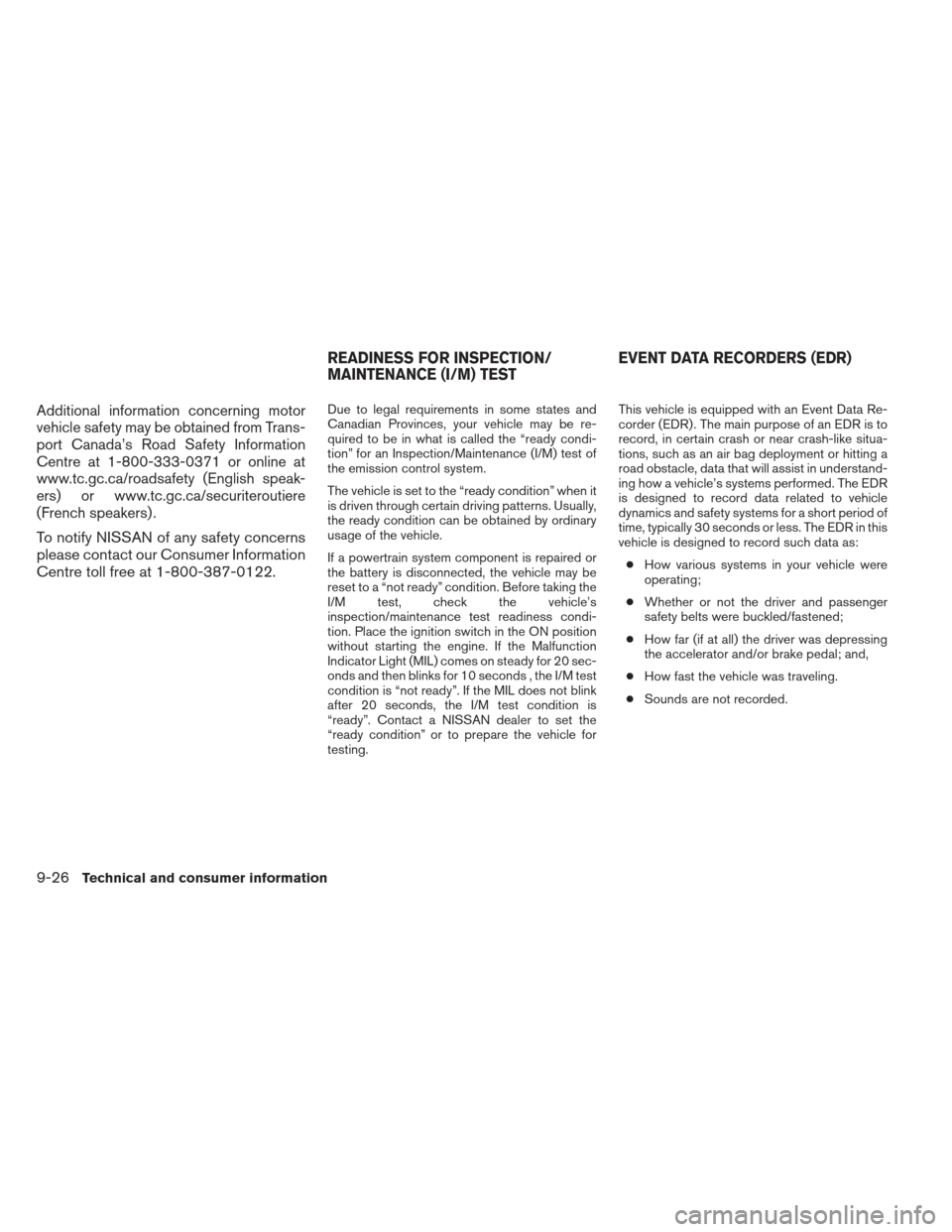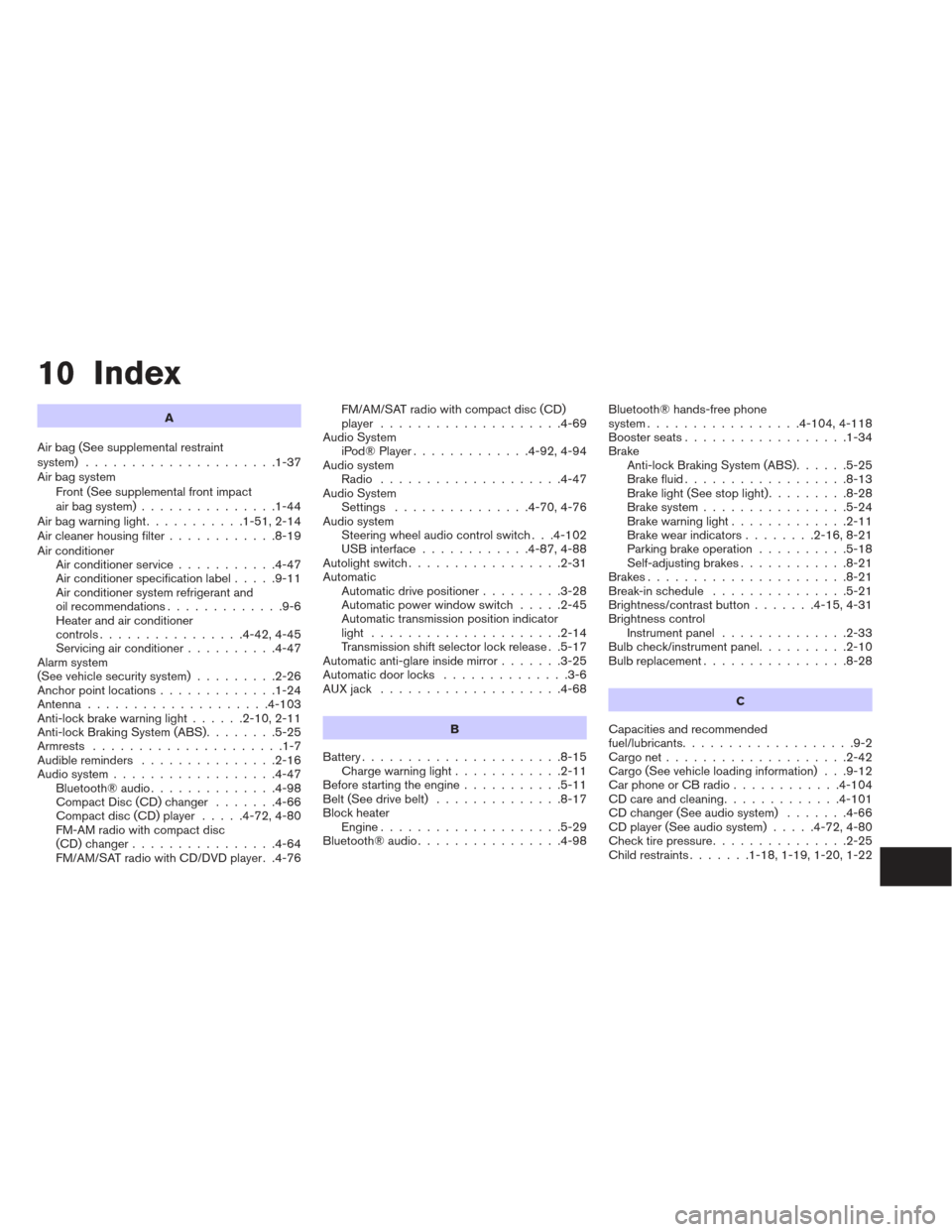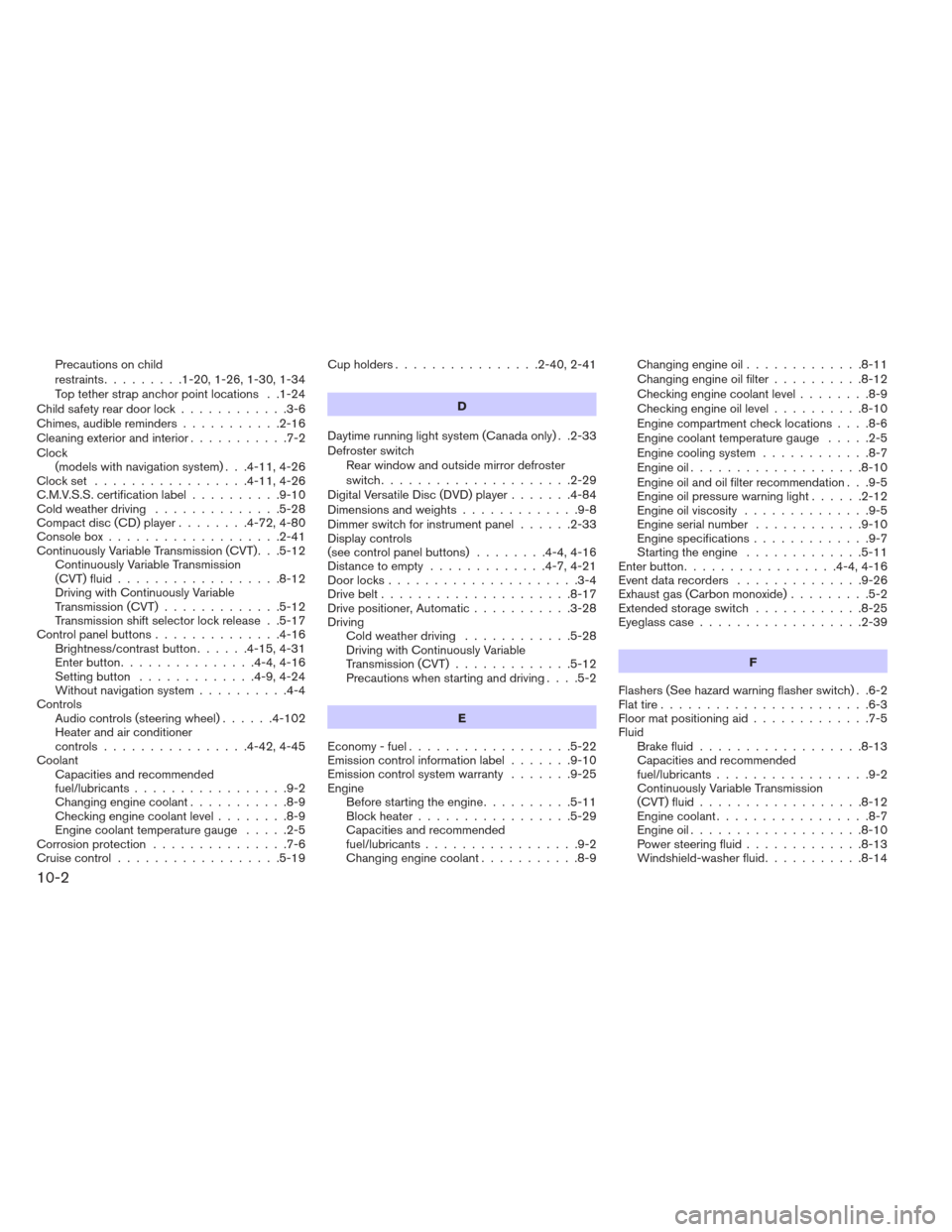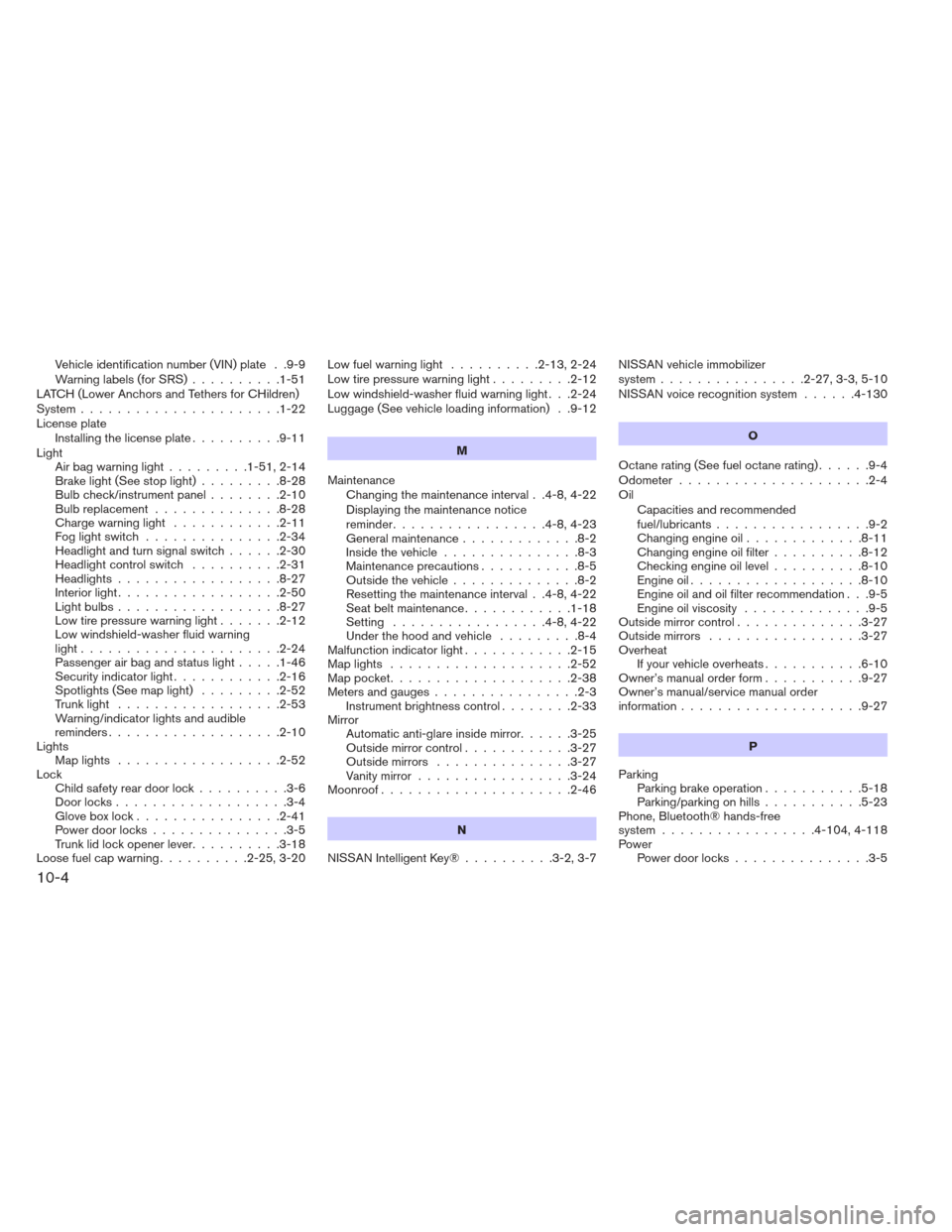2013 NISSAN MAXIMA check engine
[x] Cancel search: check enginePage 430 of 444

2. When the trailer sway stops, gently apply thebrakes and pull to the side of the road in a
safe area.
3. Try to rearrange the trailer load so it is bal- anced as described earlier in this section.
● Be careful when passing other vehicles.
Passing while towing a trailer requires con-
siderably more distance than normal pass-
ing. Remember, the length of the trailer must
also pass the other vehicle before you can
safely change lanes.
● Downshift the transmission to a lower gear
for engine braking when driving down steep
or long hills. This will help slow the vehicle
without applying the brakes.
● Avoid holding the brake pedal down too long
or too frequently. This could cause the
brakes to overheat, resulting in reduced
braking efficiency.
● Increase your following distance to allow for
greater stopping distances while towing a
trailer. Anticipate stops and brake gradually.
● NISSAN recommends that the cruise con-
trol not be used while towing a trailer. ●
Some states or provinces have specific
regulations and speed limits for vehicles that
are towing trailers. Obey the local speed
limits.
● Check your hitch, trailer wiring harness con-
nections, and trailer wheel lug nuts after
50 miles (80 km) of travel and at every break.
● When launching a boat, don’t allow the wa-
ter level to go over the exhaust tail pipe or
rear bumper.
● Make sure you disconnect the trailer lights
before backing the trailer into the water or
the trailer lights may burn out.
When towing a trailer, transmission fluid
should be changed more frequently. For
additional information, see the “Mainte-
nance and do-it-yourself” section earlier in
this manual.
FLAT TOWING
Towing your vehicle with all four wheels on the
ground is sometimes called flat towing. This
method is sometimes used when towing a vehicle
behind a recreational vehicle, such as a motor
home.
CAUTION
● Failure to follow these guidelines can
result in severe transmission damage.
● Whenever flat towing your vehicle, al-
ways tow forward, never backward.
● DO NOT tow any automatic transmis-
sion vehicle with all four wheels on the
ground (flat towing) . Doing so WILL
DAMAGE internal transmission parts
due to lack of transmission lubrication.
● For emergency towing procedures refer
to “Towing recommended by NISSAN”
in the “In case of emergency” section of
this manual.
Continuously Variable Transmission
To tow a vehicle equipped with a continuously
variable transmission, an appropriate vehicle
dolly MUST be placed under the towed vehicle’s
drive wheels. Alwaysfollow the dolly manufac-
turer’s recommendations when using their prod-
uct.
Technical and consumer information9-23
Page 433 of 444

Additional information concerning motor
vehicle safety may be obtained from Trans-
port Canada’s Road Safety Information
Centre at 1-800-333-0371 or online at
www.tc.gc.ca/roadsafety (English speak-
ers) or www.tc.gc.ca/securiteroutiere
(French speakers) .
To notify NISSAN of any safety concerns
please contact our Consumer Information
Centre toll free at 1-800-387-0122.
Due to legal requirements in some states and
Canadian Provinces, your vehicle may be re-
quired to be in what is called the “ready condi-
tion” for an Inspection/Maintenance (I/M) test of
the emission control system.
The vehicle is set to the “ready condition” when it
is driven through certain driving patterns. Usually,
the ready condition can be obtained by ordinary
usage of the vehicle.
If a powertrain system component is repaired or
the battery is disconnected, the vehicle may be
reset to a “not ready” condition. Before taking the
I/M test, check the vehicle’s
inspection/maintenance test readiness condi-
tion. Place the ignition switch in the ON position
without starting the engine. If the Malfunction
Indicator Light (MIL) comes on steady for 20 sec-
onds and then blinks for 10 seconds , the I/M test
condition is “not ready”. If the MIL does not blink
after 20 seconds, the I/M test condition is
“ready”. Contact a NISSAN dealer to set the
“ready condition” or to prepare the vehicle for
testing.This vehicle is equipped with an Event Data Re-
corder (EDR) . The main purpose of an EDR is to
record, in certain crash or near crash-like situa-
tions, such as an air bag deployment or hitting a
road obstacle, data that will assist in understand-
ing how a vehicle’s systems performed. The EDR
is designed to record data related to vehicle
dynamics and safety systems for a short period of
time, typically 30 seconds or less. The EDR in this
vehicle is designed to record such data as:
● How various systems in your vehicle were
operating;
● Whether or not the driver and passenger
safety belts were buckled/fastened;
● How far (if at all) the driver was depressing
the accelerator and/or brake pedal; and,
● How fast the vehicle was traveling.
● Sounds are not recorded.
READINESS FOR INSPECTION/
MAINTENANCE (I/M) TEST EVENT DATA RECORDERS (EDR)
9-26Technical and consumer information
Page 436 of 444

10 Index
A
Air bag (See supplemental restraint
system) .....................1-37
Air bag system Front (See supplemental front impact
air bag system) ...............1-44
Airbagwarninglight...........1-51,2-14
Air cleaner housing filter ............8-19
Air conditioner Air conditioner service ...........4-47
Air conditioner specification label .....9-11
Air conditioner system refrigerant and
oil recommendations .............9-6
Heater and air conditioner
controls................4-42,4-45
Servicing air conditioner ..........4-47
Alarm system
(See vehicle security system) .........2-26
Anchor point locations .............1-24
Antenna....................4-103
Anti-lock brake warning light ......2-10,2-11
Anti-lock Braking System (ABS) ........5-25
Armrests .....................1-7
Audible reminders ...............2-16
Audio system ..................4-47
Bluetooth®audio..............4-98
Compact Disc (CD) changer .......4-66
Compact disc (CD) player .....4-72,4-80
FM-AM radio with compact disc
(CD) changer ................4-64
FM/AM/SAT radio with CD/DVD player . .4-76 FM/AM/SAT radio with compact disc (CD)
player ....................4-69
Audio System iPod®Player.............4-92,4-94
Audio system Radio ....................4-47
Audio System Settings ...............4-70,4-76
Audio system Steering wheel audio control switch . . .4-102
USB interface ............4-87,4-88
Autolight switch .................2-31
Automatic Automatic drive positioner .........3-28
Automatic power window switch .....2-45
Automatic transmission position indicator
light .....................2-14
Transmission shift selector lock release . .5-17
Automatic anti-glare inside mirror .......3-25
Automatic door locks ..............3-6
AUXjack ....................4-68
B
Battery ......................8-15
Chargewarninglight............2-11
Before starting the engine ...........5-11
Belt (See drive belt) ..............8-17
Block heater Engine ....................5-29
Bluetooth®audio................4-98 Bluetooth® hands-free phone
system
.................4- 104, 4-118
Boosterseats..................1-34
Brake Anti-lock Braking System (ABS) ......5-25
Brakefluid..................8-13
Brakelight(Seestoplight).........8-28
Brake system ................5-24
Brake warning light .............2-11
Brake wear indicators ........2-16,8-21
Parking brake operation ..........5-18
Self-adjusting brakes ............8-21
Brakes ......................8-21
Break-inschedule ...............5-21
Brightness/contrast button .......4-15,4-31
Brightness control Instrument panel ..............2-33
Bulb check/instrument panel ..........2-10
Bulbreplacement................8-28
C
Capacities and recommended
fuel/lubricants ...................9-2
C
argonet....................2-42
Cargo (See vehicle loading information) . . .9-12
CarphoneorCBradio............4-104
CDcareandcleaning.............4-101
CD changer (See audio system) .......4-66
CD player (See audio system) .....4-72,4-80
Check tire pressure ...............2-25
Child restraints .......1-18,1-19,1-20,1-22
Page 437 of 444

Precautions on child
restraints.........1-20,1-26,1-30,1-34
Top tether strap anchor point locations . .1-24
Child safety rear door lock ............3-6
Chimes, audible reminders ...........2-16
Cleaningexteriorandinterior...........7-2
Clock (models with navigation system) . . .4-11, 4-26
Clockset .................4-11,4-26
C.M.V.S.S. certification label ..........9-10
Cold weather driving ..............5-28
Compact disc (CD) player ........4-72,4-80
Console box ...................2-41
Continuously Variable Transmission (CVT). . .5-12 Continuously Variable Transmission
(CVT) fluid ..................8-12
Driving with Continuously Variable
Transmission (CVT) .............5-12
Transmission shift selector lock release . .5-17
Controlpanelbuttons..............4-16 Brightness/contrast button ......4-15,4-31
Enterbutton...............4-4,4-16
Setting button .............4-9,4-24
Without navigation system ..........4-4
Controls Audiocontrols(steeringwheel)......4-102
Heater and air conditioner
controls ................4-42,4-45
Coolant Capacities and recommended
fuel/lubricants .................9-2
Changing engine coolant ...........8-9
Checking engine coolant level ........8-9
Engine coolant temperature gauge .....2-5
Corrosionprotection ...............7-6
Cruise control ..................5-19 Cupholders................2-40,2-41
D
Daytime running light system (Canada only) . .2-33
Defroster switch Rear window and outside mirror defroster
switch.....................2-29
Digital Versatile Disc (DVD) player .......4-84
Dimensionsandweights.............9-8
Dimmer switch for instrument panel ......2-33
Display controls
(seecontrolpanelbuttons) ........4-4,4-16
Distance to empty .............4-7,4-21
Door locks .....................3-4
Drive belt .....................8-17
Drive positioner, Automatic ...........3-28
Driving Cold weather driving ............5-28
Driving with Continuously Variable
Transmission (CVT) .............5-12
Precautions when starting and driving ....5-2
E
Economy - fuel ..................5-22
Emission control information label .......9-10
Emission control system warranty .......9-25
Engine Before starting the engine ..........5-11
Block heater .................5-29
Capacities and recommended
fuel/lubricants .................9-2
Changing engine coolant ...........8-9 Changingengineoil.............8-11
Changing engine oil filter
..........8-12
Checking engine coolant level ........8-9
Checking engine oil level ..........8-10
Engine compartment check locations ....8-6
Engine coolant temperature gauge .....2-5
Engine cooling system ............8-7
Engine oil ...................8-10
Engine oil and oil filter recommendation . . .9-5
Engine
oil pressure warning light ......2-12
Engine oil viscosity ..............9-5
Engine serial number ............9-10
Engine specifications .............9-7
Starting the engine .............5-11
Enterbutton.................4-4,4-16
Eventdatarecorders ..............9-26
Exhaust gas (Carbon monoxide) .........5-2
Extended storage switch ............8-25
Eyeglass case ..................2-39
F
Flashers (See hazard warning flasher switch) . .6-2
Flat tire .......................6-3
Floor mat positioning aid .............7-5
Fluid Brake fluid ..................8-13
Capacities and recommended
fuel/lubricants .................9-2
Continuously Variable Transmission
(CVT)fluid..................8-12
Engine coolant .................8-7
Engine oil ...................8-10
Power steering fluid .............8-13
Windshield-washer fluid ...........8-14
10-2
Page 439 of 444

Vehicle identification number (VIN) plate . .9-9
Warning labels (for SRS)..........1-51
LATCH (Lower Anchors and Tethers for CHildren)
System ......................1-22
License plate Installing the license plate ..........9-11
Light Airbagwarninglight.........1-51,2-14
Brakelight(Seestoplight).........8-28
Bulb check/instrument panel ........2-10
Bulb replacement ..............8-28
Chargewarninglight ............2-11
Foglightswitch ...............2-34
Headlight and turn signal switch ......2-30
Headlightcontrolswitch ..........2-31
Headlights..................8-27
Interiorlight..................2-50
Lightbulbs..................8-27
Low tire pressure warning light .......2-12
Low windshield-washer fluid warning
light......................2-24
Passenger air bag and status light .....1-46
Security indicator light ............2-16
Spotlights (See map light) .........2-52
Trunklight ..................2-53
Warning/indicator lights and audible
reminders ...................2-10
Lights Maplights ..................2-52
Lock Child safety rear door lock ..........3-6
Door locks ...................3-4
Gloveboxlock................2-41
Power door locks ...............3-5
Trunk lid lock opener lever ..........3-18
Loose fuel cap warning ..........2-25,3-20 Lowfuelwarninglight ..........2-13,2-24
Low tire pressure warning light
.........2-12
Low windshield-washer fluid warning light . . .2-24
Luggage (See vehicle loading information) . .9-12
M
Maintenance Changing the maintenance interval . .4-8, 4-22
Displaying the maintenance notice
reminder .................4-8,4-23
Generalmaintenance.............8-2
Insidethevehicle...............8-3
Maintenance precautions ...........8-5
Outside the vehicle ..............8-2
Resetting the maintenance interval . .4-8, 4-22
Seatbeltmaintenance............1-18
Setting .................4-8,4-22
Underthehoodandvehicle .........8-4
Malfunction indicator light ............2-15
Maplights ....................2-52
Map pocket ....................2-38
Meters and gauges ................2-3
Instrument brightness control ........2-33
Mirror Automatic anti-glare inside mirror ......3-25
Outside mirror control ............3-27
Outside mirrors ...............3-27
Vanity mirror .................3-24
Moonroof .....................2-46
N
NISSAN Intelligent Key® ..........3-2,3-7 NISSAN vehicle immobilizer
system
................2-27,3-3,5-10
NISSAN voice recognition system ......4-130
O
Octane rating (See fuel octane rating) ......9-4
Odometer .....................2-4
Oil Capacities and recommended
fuel/lubricants .................9-2
Changingengineoil.............8-11
Changing engine oil filter ..........8-12
Checking engine oil level ..........8-10
Engine oil ...................8-10
Engine oil and oil filter recommendation . . .9-5
Engine oil viscosity ..............9-5
Outside mirror control ..............3-27
Outside mirrors .................3-27
Overheat If
your vehicle overheats ...........6-10
Owner’s manual order form ...........9-27
Owner’s manual/service manual order
information ....................9-27
P
Parking Parking brake operation ...........5-18
Parking/parking on hills ...........5-23
Phone, Bluetooth® hands-free
system .................4- 104, 4-118
Power Power door locks ...............3-5
10-4